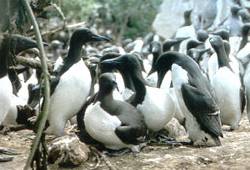Common Guillemot
|
|
| Common Guillemot | ||||||||||||||
|---|---|---|---|---|---|---|---|---|---|---|---|---|---|---|
 | ||||||||||||||
| Scientific classification | ||||||||||||||
| ||||||||||||||
| Binomial name | ||||||||||||||
| Uria aalge (Pontopiddan, 1763) |
The Common Guillemot, known as the Common Murre in North America, Uria aalge, is a large alcid.
Adult birds are 38-46 cm in length, with a 61-73 cm wingspan. They are black on the head, back and wings, and have white underparts. They have a thin dark pointed bill and a small rounded dark tail. The face becomes white in winter. Western European birds of the race U. a. albionis are dark brown rather than black, most obviously so in colonies in southern Britain.
Their breeding habitat is islands, rocky shores, cliffs and sea stacks on
- North Atlantic coasts, in North America as far south as New Brunswick, and in Europe as far south as Portugal.
- The north Pacific coasts of Alaska and British Columbia down to California.
They usually nest in tight-packed colonies and lay their eggs on bare rock ledges or ground. The eggs are pointed, so that if disturbed they roll in a circle rather than fall off the ledge. Eggs are also variable in colour and pattern, probably to aid recognition.
Some birds are permanent residents; northern birds migrate south to open waters near New England, southern California and the western Mediterranean.
These birds forage for food by swimming underwater. They mainly eat small schooling fish (max. 200mm long), also some crustaceans, marine worms and squid. Diving depths up to 50 m were recorded.
See also
de:Trottellumme fi:Etelänkiisla gl:Arao dos cons it:Uria aalge ja:ウミガラス
